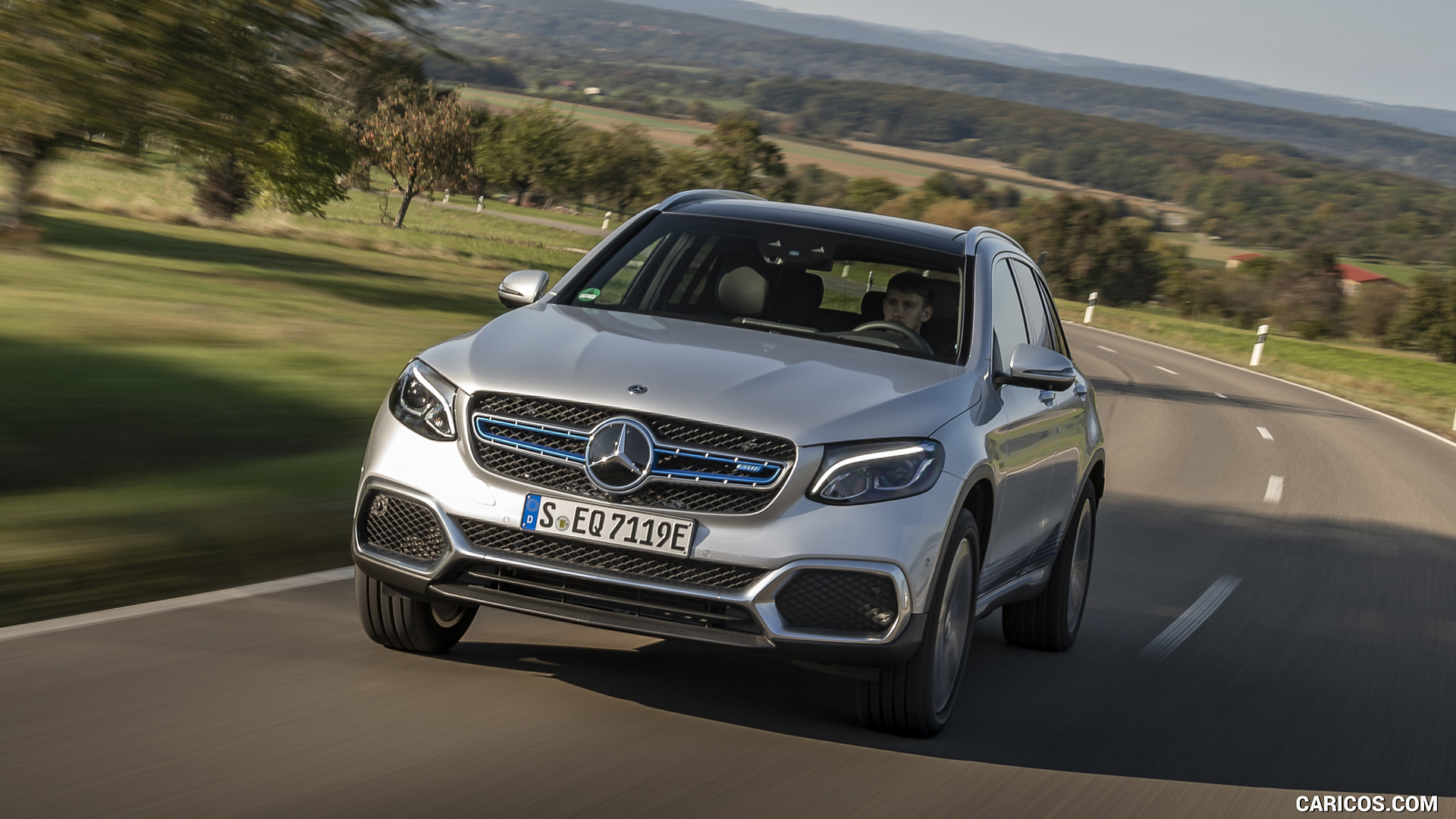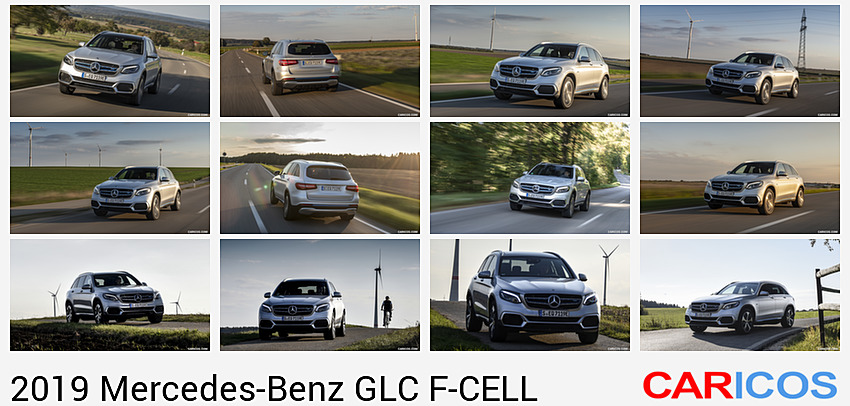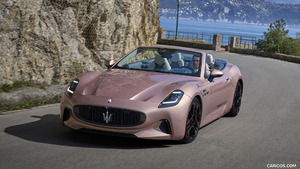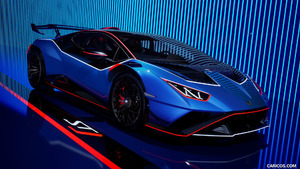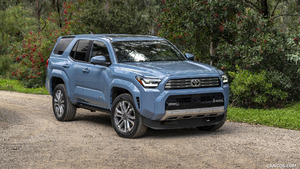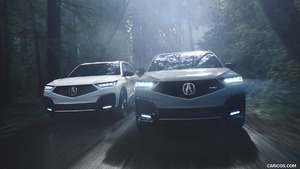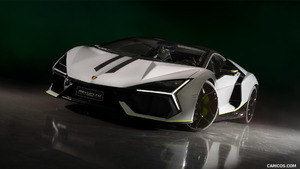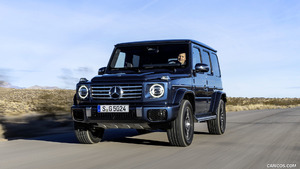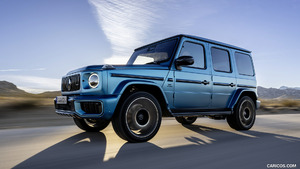Mercedes-Benz GLC F-CELL
The Mercedes-Benz GLC F‑CELL (combined hydrogen consumption 0.34 kg/100 km, combined CO2 emissions 0 g/km, combined electrical consumption 13.7 kWh/100 km)1 is a unique plug-in hybrid as it combines innovative fuel-cell and battery technologies for the first time: apart from electricity, it also runs on pure hydrogen. Intelligent interplay between battery and fuel cell, long range, and short refuelling times make the GLC F‑CELL a vehicle of high everyday practicality and also suitable for short and long-distance motoring. With 4.4 kg of hydrogen on board, the SUV generates enough energy for a range of up to 478 km1 in hybrid mode. The large lithium-ion battery delivers up to 51 km1 of range in the NEDC. An output of 155 kW guarantees both dynamic performance and locally emission-free driving pleasure. Initial vehicles are to be handed over to selected customers at the end of October.
The GLC F-CELL represents an important step by Mercedes-Benz in the development of fuel cell technology. It features a totally new fuel cell system which is so compact that the entire system can be housed in the engine compartment for the first time and installed at the same mounting points as a conventional engine. In addition, the use of platinum in the fuel cell has been reduced by 90 percent in comparison to the predecessor vehicle. Consequently resources are conserved, and system costs are cut without impairing performance. Two carbon-fibre-encased tanks built into the vehicle floor hold 4.4 kg of hydrogen. Thanks to globally standardised 700-bar tank technology, the supply of hydrogen can be replenished within just three minutes - as quickly as is customary when refuelling a combustion-engined car.
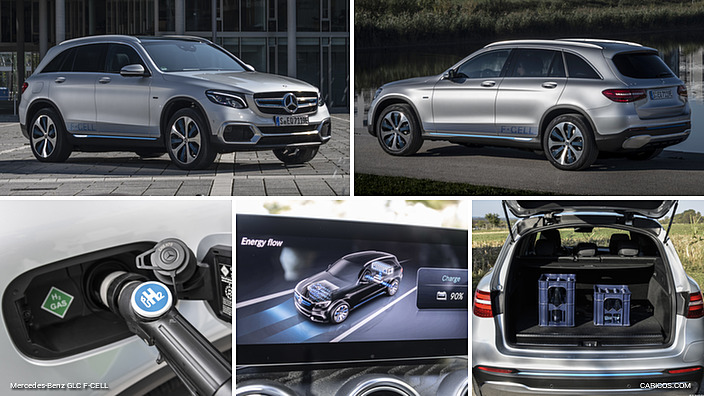 2019 Mercedes-Benz GLC F-CELL
2019 Mercedes-Benz GLC F-CELL
The lithium-ion battery has a gross capacity of 13.5 kWh and additionally serves as an energy source for the electric motor. Plug-in technology makes it easy to charge via the 7.4 kW on-board charger at a standard household socket, a wallbox or a public charging station – from 10 to 100 percent SoC (State of Charge) in approx. 1.5 hours if the full power is used. Just like the drive motor, an asynchronous motor with an output of 155 kW (211 hp) and a torque of 365 Nm, the powerful storage battery is space-savingly installed in the rear of the SUV.
Coordinated: operating strategy with a unique variety of combinations
The innovative plug-in fuel-cell drive combines the advantages of both zero-emission drive technologies and, thanks to its intelligent operating strategy, continuously optimises the use of both energy sources in line with the current operating situation. This is also influenced by the selected drive program: ECO, COMFORT or SPORT..
There are four operating modes:
- HYBRID: the vehicle draws power from both energy sources. Power peaks are handled by the battery, while the fuel cell runs in the optimum efficiency range.
- F-CELL: the state of charge of the high-voltage battery is kept constant by the energy from the fuel cell. Only hydrogen is consumed. This mode is ideal for steady cruising over long distances.
- BATTERY: the GLC F-CELL runs all-electrically and is powered by the high-voltage battery. The fuel-cell system is not in operation. This is the ideal mode for short distances.
- CHARGE: charging the high-voltage battery has priority, for example in order to recharge the battery for the maximum overall range prior to refuelling with hydrogen or to create power reserves.
In all operating modes, the system features an energy recovery function, which makes it possible to recover energy during braking or coasting and to store it in the battery.
The battery and all components containing hydrogen are governed by particularly stringent safety standards typical of Mercedes. Alongside safety in the event of a crash, all Mercedes-Benz vehicles undergo additional component tests at system level that go far beyond the usual tests. The powertrain components and hydrogen tanks of the F-CELL pre-series vehicles are space-savingly and safely housed in the engine compartment as well as in the vehicle underbody.
Mercedes-Benz's safety assistance systems are also all on board the GLC F‑CELL. Their sensors have an additional purpose in vehicles that run purely on electric power in that their signals assist the powertrain control with the selection of a range-preserving, efficient strategy for using the on-board energy sources. The energy employed for accelerating the car is used intelligently, taking account of the route characteristics, topography and traffic situation. The driver can always set other priorities, of course, but subtle hints inform them of what they can do intuitively to optimise the vehicle range.
Self-assured: with the DNA of a genuine Mercedes
Despite the extraordinary powertrain concept, the GLC F-CELL boasts the everyday practicality and comfort people have come to expect from a Mercedes‑Benz. Even the luggage compartment remains unchanged, with the exception of a minimal step, and the rear seats are only slightly higher positioned in order to make space for the hydrogen tanks. The climate comfort in the GLC F-CELL is on a par with conventional vehicles, and the pre-entry climate control based on mains charging current is an intelligent way of safeguarding the vehicle's range. At cooler temperatures, the vehicle will make energy-efficient use of the waste heat from the fuel cell in order to optimise the energy balance of the vehicle.
Remote retrieval of vehicle status via Mercedes me provides a wealth of information: current hydrogen tank level and current battery charging status as well as current range, mileage covered, driving time and consumption since the last start or since the last trip odometer reset.
The GLC F-CELL is equipped with coil springs on the front axle and with single-chamber air suspension with integral automatic level control on the rear axle. This means that, even when the vehicle is carrying a load, there is no change in spring travel at the rear axle, which guarantees balanced vibration characteristics with a virtually constant natural frequency of the body, even when the vehicle is loaded.
Marketing focus on H2 cities
The market launch of the GLC F-CELL is imminent. Initial vehicles are to be handed over to selected customers at the end of October.The market launch will focus above all on major cities which are already comparatively well equipped with hydrogen filling stations: Berlin, Hamburg, Frankfurt, Stuttgart, Munich, Cologne and Düsseldorf. The GLC F-CELL, which features an excellent scope of equipment as standard, will be available solely in the form of a full-service rental model.This will include all maintenance and possible repairs together with a comprehensive warranty package covering the entire rental period.
Production: global competence network
During production of the innovative fuel-cell drive, Daimler is able to call upon its global competence network. The heart of the technology, the fuel-cell stack, is produced at Mercedes-Benz Fuel Cell (MBFC) in Vancouver, Canada. The entire fuel-cell unit and the hydrogen storage system were developed by the Daimler subsidiary NuCellSys in Kirchheim/Nabern in Baden-Württemberg. The Daimler parent plant in Untertürkheim is responsible for fuel-cell system assembly, also in Nabern. The hydrogen tank system, consisting of carbon-fibre-encased tanks, is produced at Daimler's Mannheim plant, while the lithium-ion battery comes from the wholly owned Daimler subsidiary ACCUMOTIVE in Kamenz, Saxony. The fully fledged, family-friendly everyday SUV is produced in Bremen, just like the GLC with conventional drive.
Pioneers: Daimler has been working on the fuel cell for over 30 years
Daimler researchers have been tinkering with this technology since the 1980s. In 1994, Mercedes-Benz unveiled the first fuel-cell vehicle to the global public – the NECAR 1. Many other vehicles followed: to date, fuel-cell vehicles from Mercedes-Benz, including the B-Class F-CELL, have together covered over eighteen million kilometres, thereby demonstrating the maturity of the powertrain concept.
The infrastructure is essential
A full-coverage infrastructure is essential to the success of electric mobility. The spread of both charging stations and hydrogen filling stations is proceeding apace around the world. Whether at home, at work, on the road or when shopping: there are various ways to supply electric vehicles with power. Also when it comes to the H2 infrastructure, progress is constantly being made. Together with its partners in the H2 Mobility joint venture, Daimler has already drawn up a concrete action plan. By the end of next year the H2 filling station network is to be expanded from its current level of 51 to 100 stations. The partners' long-term objective is a network with up to 400 hydrogen refuelling stations. Similar infrastructure projects are being promoted in Europe, the USA and Japan.
Technical data
| GLC F-CELL1 | |
| Combined CO2 emissions (g/km) | 0 |
| Combined hydrogen consumption in hybrid mode (kg/100 km) | 0.34 |
| Combined electrical consumption (kWh/100 km) | 13,7 |
| H2 range in hybrid mode (NEDC) (km) | 478 |
| Battery-electric range in battery mode (NEDC) (km) | 51 |
| Engine | Electric motor |
| Rated output (kW/hp) | 155 (211) |
| Peak torque (Nm) | 365 |
| Battery | Lithium-ion |
| Energy content (gross/net) (kWh) | 13,5 /9,3 |
| Fuel cell | PEM |
| H2 tank capacity (kg) (usable for SAE J2601, 2014 or more recent) | 4.4 |
| Top speed (km/h) | 160 (governed) |
| Length (mm) | 4.671 |
| Width (mm) | 2096 |
| Height (mm) | 1.653 |
| Track width (mm) | 1625 (front axle) | 1621 (rear axle) |
| Wheelbase (mm) | 2873 |
1 Figures for fuel consumption, electrical consumption and CO2 emissions are provisional and were determined by the technical service for the certification process in accordance with the WLTP test method and correlated into NEDC figures. EC type approval and certificate of conformity with official figures are not yet available. Differences between the stated figures and the official figures are possible.
